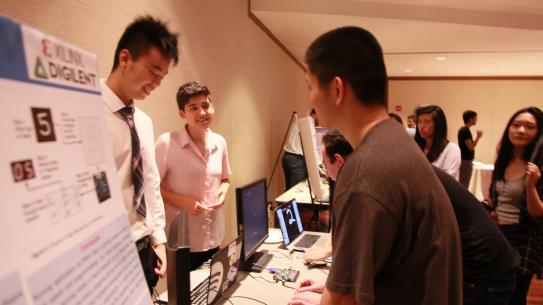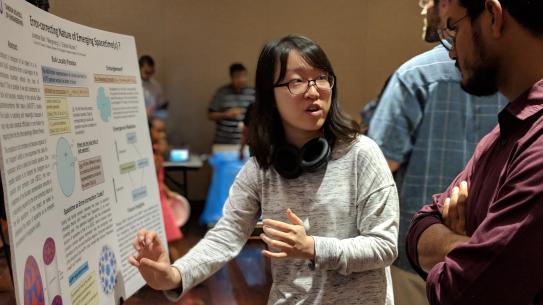Undergraduates Unravel the Mysteries of Time, Space, and Fish Hydrodynamics through Summer Research

Student researchers from NYU Tandon were joined by students from NYU’s College of Liberal Arts and Sciences, as well as students from nearby universities to display their research at NYU's Kimmel Center.
Last Friday, undergraduate researchers gathered in NYU’s Kimmel Center for University Life to display the results of months of investigation on everything from holograms to hydrodynamics. Among the attendees were over 100 students from NYU's Tandon School of Engineering, who displayed posters summarizing their research; they were joined by students from NYU’s College of Liberal Arts and Sciences, as well as students from nearby universities.
Sara-Lee Ramsawak, the organizer of the event, noted that the gathering was the largest undergraduate summer research expo to date. “The number of renowned faculty, coupled with the hard-working, ambitious students, has made for such a successful program,” said Ramsawak, who is Associate Director of Academic Affairs at NYU Tandon. “This year’s Summer Research Symposium also expanded to include not only the 121 members of Tandon's program, but also members of the NYU College of Arts & Science Research Experience programs, and students that participated in Columbia University and Princeton University's programs.”
New Types of Computing: FPGAs
Tara Umesh exhibited her team’s research on increasing the speed of computers by skipping the traditional methods of running software. She and research partners Ziyao Shangguan and Yining Wang explained the project’s unconventional approach: “Traditionally, apps run on software: a computer with a microprocessor chip runs the app. Our research focuses on running apps directly on hardware.” While this process sounds simple, there are complicated steps before apps can run directly on hardware. Employing reconfigurable chips to bypass using software, the team converted apps into circuits with hardware development tools before programming the reconfigurable chip to emulate the circuits. So far, they’ve implemented classic games Tetris and Pong on the reconfigurable chips. The team conducted their project under Tandon Computer Science and Engineering Professor Haldun Hadimioglu and Electrical Engineering doctoral candidate Mohamed El Massad.

U•START
Notable amongst the presenters were students who are researching and building U•START, a platform encouraging start-up creation and advancement for recent graduates. “A lot of times, students end up graduating lacking experience, or lacking the necessary means to initiate their own startup,” explained Tark Hassoun, the platform's backend developer. “What U•START does is offer the means to do so by allowing users to advertise their skills and projects through their profiles, connect with other experienced individuals, and launch startups with the right tools.” Hassoun worked with teammates Ryan Rozbiani (the founder of U•START), Minhazur Bhuiyan, Steven Armanios, Yunjie Hu, Gary Chi, Kevin Zeng, GeonPyung Lee, and Danny Hu to create and research the platform, which was developed using Elasticsearch and the Google-made programming language Golang. The team was aided by academic advisor Fred Strauss.

Error-correcting Nature of Emerging Spacetimes
Mengmeng Li, of the NYU Shanghai campus, attended the expo to display her work with partner Edison Murairi of NYU Abu Dhabi. Their research, which was supported by NYU Tandon Professor Jonathan Bain, focused on constructing holograms in specific, constrictive spacetimes without losing the information conveyed by the hologram. Li explained that the research is critical to modern physicists: “In this project, we seek to understand the nature of spacetime as an emergent phenomenon in holographic duality, which is at the forefront of theoretical physics.” Li noted that exploring how to solve this problem took much time and effort. “During the past two months, we have read through and discussed roughly 30 papers mainly in the area of theoretical physics, plus some papers in philosophy of science under the supervision of [Professor Bain],” Li said, “He walks us through important concepts; for example, the condensed matter approach to the emergence of gravity, and debates about string theory.”

Investigating Hydrodynamic Interactions Underlying Fish Swimming
Students Boris Arbuzov and Elizabeth Krasner shared with symposium attendees their research into locomotory patterns of fish. “How the fish align their bodies to achieve coordinated swimming is still not well understood,” explained Arbuzov. “As a first attempt to understand fish schooling, we designed controlled experiments to quantify how a fish reacts to disturbances in the flow created by a neighboring fish.” The experiments involved designing a tunnel for live fish, and placing an airfoil “upstream” that simulated a moving fish’s tail. How fish moved and adapted to the motion of the airfoil was recorded and analyzed to help clarify the role of hydrodynamics in schools of fish. Dr. Peng Zhang served as the team’s mentor, and they also received guidance from NYU Tandon Professor Maurizio Porfiri, a leading expert in fluid mechanics and director of the Dynamical Systems Laboratory.

Annie Brinich
NYU Tandon School of Engineering
Master of Science in Integrated Digital Media, Class of 2019




